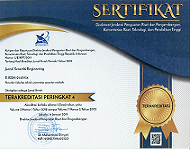Pengaruh Kuat Tekan Beton Dengan Menggunakan Kapur Dan Silica Fume Sebagai Bahan Tambah Semen
Keywords:
Compressive strength, lime, silica fume, cement, substitutionAbstract
Cement is the main material in concrete production; however, its manufacturing process generates significant CO₂ emissions that negatively affect the environment. Therefore, alternative materials are needed to partially replace cement with more environmentally friendly options. This study aims to analyze the effect of lime and silica fume on the compressive strength of concrete and compare the results with normal concrete. The research was conducted using an experimental method with three variations of concrete mixtures: normal concrete, concrete with 5% substitution of lime and silica fume, and concrete with 10% substitution based on cement weight. The results showed that normal concrete achieved an average compressive strength of approximately 20.6 MPa. At 5% substitution, the compressive strength increased to 21.258 MPa (an improvement of about 3.17%), while at 10% substitution it reached 21.898 MPa (an improvement of about 6.29%). These findings indicate that the addition of lime and silica fume can enhance the compressive strength of concrete, although the improvement is relatively minor. Further analysis is required to determine whether this difference is technically significant or merely a result of experimental variation. Overall, lime and silica fume have the potential to serve as partial cement substitutes that support the development of environmentally friendly concrete while maintaining its technical performance.
References
[1] A. Setiawan, R. Rahmawati, and A. Adnan, "Pengaruh penggunaan limbah beton sebagai agregat halus terhadap uji kuat tekan paving block," Media Ilmiah Teknik Sipil, vol. 12, no. 2, pp. 101–108, 2023.
[2] H. M. Hamada et al., “Effect of silica fume on the properties of sustainable cement concrete,” Journal of Materials Research and Technology, vol. 24, pp. 8887–8908, 2023, doi: 10.1016/j.jmrt.2023.05.147.
[3] M. Olivia, M. A. Maulidi, Fadhlurrahman, and G. Wibisono, “Characteristics of palm oil fuel ash concrete admixed with precipitated silica and silica fume,” Clean Eng Technol, vol. 19, no. March, p. 100738, 2024, doi: 10.1016/j.clet.2024.100738.
[4] R. O. Tarru, “Studi Penggunaan Silica Fume Sebagai Bahan Pengisi (Filler) Pada Campuran Beton,” Journal Dynamic Saint, vol. 3, no. 1, pp. 472–485, 2018, doi: 10.47178/dynamicsaint.v3i1.271.
[5] N. Rochmah and G. Sarya, “Pengaruh Serbuk Batu Kapur terhadap Uji Tekan Beton,” RekaRacana: Jurnal Teknil Sipil, vol. 5, no. 4, p. 13, 2019, doi: 10.26760/rekaracana.v5i4.13.
[6] Sirait, Esther Glory. Pengaruh Bahan Tambah Silica Fume Terhadap Kuat Tekan Beton Mutu 25 Mpa. Diss. Universitas Komputer Indonesia, 2023.
[7] Kandi, Yufiter Silas, Ruslan Ramang, and Remigildus Cornelis. "Substitusi Agregat Halus Beton Menggunakan Kapur Alam dan Menggunakan Pasir Laut pada Campuran Beton." Jurnal Teknik Sipil 1.4 (2012): 74-86.
[8] S. Permatasari and S. Kurniawan, “Analisis Kuat Tekan Beton Mutu K-250 Terhadap Pengaruh Penambahan Batu Kapur Dari Desa Cantung Kecamatan Hampang Kabupaten Kotabaru,” TAPAK (Teknologi Aplikasi Konstruksi) : Jurnal Program Studi Teknik Sipil, vol. 11, no. 2, p. 87, 2022, doi: 10.24127/tp.v11i2.2020.
[9] N. Rochmah, “Pemanfaatan Batu Kapur Didaerah Sampang Madura Sebagai Bahan Pengganti Agregat Kasar Pada Campuran Beton,” JHP17 Jurnal Hasil Penelitian LPPM Untag Surabaya, vol. 01, no. 02, pp. 217–226, 2016.
[10] S. N. Indonesia, SNI 2847:2013: Persyaratan beton struktural untuk bangunan gedung. Jakarta: Badan Standardisasi Nasional, 2012.
[11] Taurano, “Analisis Uji Kuat Tekan Beton dengan Substitusi Kapur dan Abu Sekam Padi Sebagai Campuran Semen,” ORBITH: Majalah Ilmiah Pengembangan Rekayasa dan Sosial, vol. 17, no. 1, pp. 1–11, 2021.
[12] N. M. Utami, M. A. Baihaki, and D. Nurtanto, “Korelasi Kuat Tekan Beton Dan Ketahanan Sulfat Pada Beton Normal Dengan Penambahan Kaolin Sebagai Subtitusi Parsial Semen,” Teras Jurnal : Jurnal Teknik Sipil, vol. 13, no. 1, pp. 173–182, 2023, doi: 10.29103/tj.v13i1.807.
[13] E. Riyanto, E. Widyananto, and R. R. Renaldy, “Analisis Kuat Tekan Mortar Geopolimer Berbahan Silica Fume dan Kapur Tohor,” INERSIA: lNformasi dan Ekspose hasil Riset teknik SIpil dan Arsitektur, vol. 17, no. 1, pp. 19–26, 2021, doi: 10.21831/inersia.v17i1.35901.
[14] H. Hartono, “Studi Kuat Tekan Beton Dengan Agregat Kasar Dari Batu Kapur,” Gema Teknologi, vol. 17, no. 3, pp. 139–143, 2015, doi: 10.14710/gt.v17i3.8931.
[15] S. N. Indonesia, Cara Uji Kuat Tekan Beton Dengan Benda Uji Silinder, SNI 1974-2011. Jakarta: Badan Standardisasi Nasional, 2011.
Downloads
Published
Issue
Section
License
Copyright (c) 2025 M. Aldi Hadrian (Author)

This work is licensed under a Creative Commons Attribution 4.0 International License.












